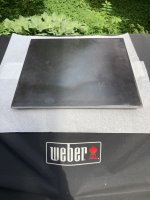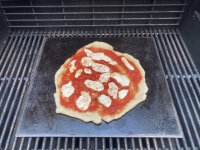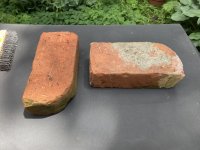Michael Grofsorean
New member
A wire brush was wholly inadequate to remove the orangish paint off of my steel, but scraping with a screwdriver moved most of it off. Then I ran out of light. Today, my palm sander mounted with 80 grit discs buzzed the paint off easily. However, there was a reddish tint on a lot of the plate and I feared that I somehow ground the removed paint back into the surface. I phoned the metal shop and was told that no, it's not the paint, but rather oxidation. So nothing to worry about. I gave the steel a kitchen sink bath in Dawn dish soap and put it back outside to dry (see photo and please pardon the vertical shadow across the steel).mine had machine oil on it. i used dawn dish soap, then dried it, then oiled both sides with vegetable oil and then placed in the the bbq to cook off and set the finish. i still add additional finish layers at different times so as to build up a nice patina and carbon over time as i keep my plate outside.
DO NOT cook it in the house with oil. you will not get that smoke and smell out for years.
i'd soften up those edges and corners. an angle grinder will do the trick.
looks like you're in for a good time. just get a laser gun to measure heat of the steel so you know what you're doing. the steel is very versatile and easy to use. less is more as the steel retains heat and has a low recovery time between pizzas, unlike ceramic or stones do.
Next step is seasoning: the metal shop dudes said do it at 250F just like cast iron. But articles such as this one say 500F for cast iron and for an hour. I cook with mostly cast iron but inherited my Lodge and Wagner skillets and never have to season them, so I don't know squat about seasoning. What do you recommend?

How to Season a Cast-Iron Skillet So That It Lasts Forever
Give a new pan a glossy black nonstick coating—or bring the luster back to a family heirloom—with this 3-step process for seasoning cast iron.
Finally, theory is that we would make our first attempt at making pizza tonight (it's already 4pm) on the steel. Now I'm not sure that I've left enough time for the seasoning step. Please advise.
P.S. Wife says 500F. She's got a carbon steel that she seasons in our oven. I don't use the thing. I use the cast iron. Grill is firing up ...
Attachments
Last edited:



